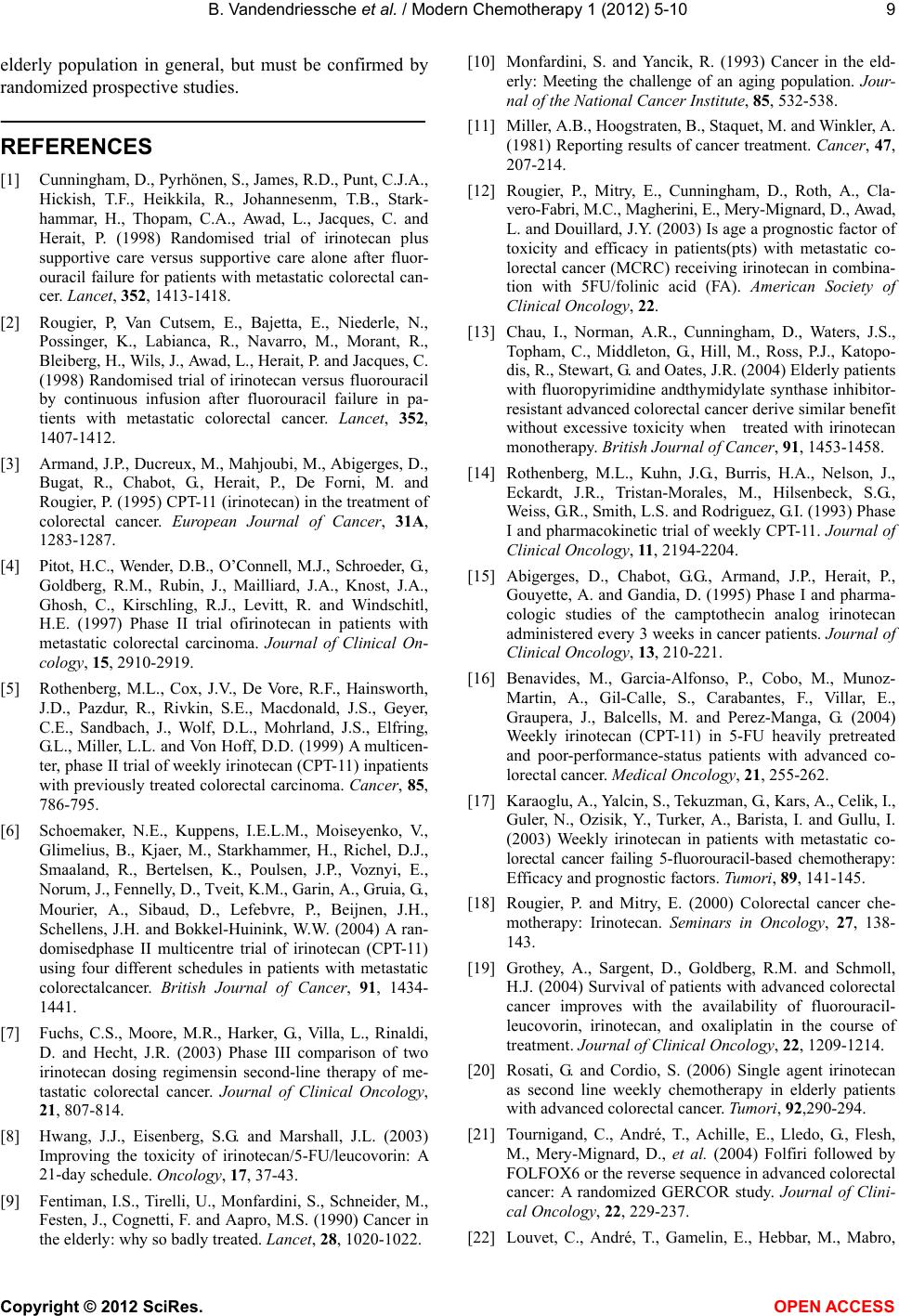
B. Vandendriessche et al. / Modern Chemotherapy 1 (2012) 5-10 9
elderly population in general, but must be confirmed by
randomized prospective studies.
REFERENCES
[1] Cunningham, D., Pyrhönen, S., James, R.D., Punt, C.J.A.,
Hickish, T.F., Heikkila, R., Johannesenm, T.B., Stark-
hammar, H., Thopam, C.A., Awad, L., Jacques, C. and
Herait, P. (1998) Randomised trial of irinotecan plus
supportive care versus supportive care alone after fluor-
ouracil failure for patients with metastatic colorectal can-
cer. Lancet, 352, 1413-1418.
[2] Rougier, P, Van Cutsem, E., Bajetta, E., Niederle, N.,
Possinger, K., Labianca, R., Navarro, M., Morant, R.,
Bleiberg, H., Wils, J., Awad, L., Herait, P. and Jacques, C.
(1998) Randomised trial of irinotecan versus fluorouracil
by continuous infusion after fluorouracil failure in pa-
tients with metastatic colorectal cancer. Lancet, 352,
1407-1412.
[3] Armand, J.P., Ducreux, M., Mahjoubi, M., Abigerges, D.,
Bugat, R., Chabot, G., Herait, P., De Forni, M. and
Rougier, P. (1995) CPT-11 (irinotecan) in the treatment of
colorectal cancer. European Journal of Cancer, 31A,
1283-1287.
[4] Pitot, H.C., Wender, D.B., O’Connell, M.J., Schroeder, G.,
Goldberg, R.M., Rubin, J., Mailliard, J.A., Knost, J.A.,
Ghosh, C., Kirschling, R.J., Levitt, R. and Windschitl,
H.E. (1997) Phase II trial ofirinotecan in patients with
metastatic colorectal carcinoma. Journal of Clinical On-
cology, 15, 2910-2919.
[5] Rothenberg, M.L., Cox, J.V., De Vore, R.F., Hainsworth,
J.D., Pazdur, R., Rivkin, S.E., Macdonald, J.S., Geyer,
C.E., Sandbach, J., Wolf, D.L., Mohrland, J.S., Elfring,
G.L., Miller, L.L. and Von Hoff, D.D. (1999) A multicen-
ter, phase II trial of weekly irinotecan (CPT-11) inpatients
with previously treated colorectal carcinoma. Cancer, 85,
786-795.
[6] Schoemaker, N.E., Kuppens, I.E.L.M., Moiseyenko, V.,
Glimelius, B., Kjaer, M., Starkhammer, H., Richel, D.J.,
Smaaland, R., Bertelsen, K., Poulsen, J.P., Voznyi, E.,
Norum, J., Fennelly, D., Tveit, K.M., Garin, A., Gruia, G.,
Mourier, A., Sibaud, D., Lefebvre, P., Beijnen, J.H.,
Schellens, J.H. and Bokkel-Huinink, W.W. (2004) A ran-
domisedphase II multicentre trial of irinotecan (CPT-11)
using four different schedules in patients with metastatic
colorectalcancer. British Journal of Cancer, 91, 1434-
1441.
[7] Fuchs, C.S., Moore, M.R., Harker, G., Villa, L., Rinaldi,
D. and Hecht, J.R. (2003) Phase III comparison of two
irinotecan dosing regimensin second-line therapy of me-
tastatic colorectal cancer. Journal of Clinical Oncology,
21, 807-814.
[8] Hwang, J.J., Eisenberg, S.G. and Marshall, J.L. (2003)
Improving the toxicity of irinotecan/5-FU/leucovorin: A
21-day schedule. Oncology, 17, 37-43.
[9] Fentiman, I.S., Tirelli, U., Monfardini, S., Schneider, M.,
Festen, J., Cognetti, F. and Aapro, M.S. (1990) Cancer in
the elderly: why so badly treated. Lancet, 28, 1020-1022.
[10] Monfardini, S. and Yancik, R. (1993) Cancer in the eld-
erly: Meeting the challenge of an aging population. Jour-
nal of the National Cancer Institute, 85, 532-538.
[11] Miller, A.B., Hoogstraten, B., Staquet, M. and Winkler, A.
(1981) Reporting results of cancer treatment. Cancer, 47,
207-214.
[12] Rougier, P., Mitry, E., Cunningham, D., Roth, A., Cla-
vero-Fabri, M.C., Magherini, E., Mery-Mignard, D., Awad,
L. and Douillard, J.Y. (2003) Is age a prognostic factor of
toxicity and efficacy in patients(pts) with metastatic co-
lorectal cancer (MCRC) receiving irinotecan in combina-
tion with 5FU/folinic acid (FA). American Society of
Clinical Oncology, 22.
[13] Chau, I., Norman, A.R., Cunningham, D., Waters, J.S.,
Topham, C., Middleton, G., Hill, M., Ross, P.J., Katopo-
dis, R., Stewart, G. and Oates, J.R. (2004) Elderly patients
with fluoropyrimidine andthymidylate synthase inhibitor-
resistant advanced colorectal cancer derive similar benefit
without excessive toxicity when treated with irinotecan
monotherapy. British Journal of Cancer, 91, 1453-1458.
[14] Rothenberg, M.L., Kuhn, J.G., Burris, H.A., Nelson, J.,
Eckardt, J.R., Tristan-Morales, M., Hilsenbeck, S.G.,
Weiss, G.R., Smith, L.S. and Rodriguez, G.I. (1993) Phase
I and pharmacokinetic trial of weekly CPT-11. Journal of
Clinical Oncology, 11, 2194-2204.
[15] Abigerges, D., Chabot, G.G., Armand, J.P., Herait, P.,
Gouyette, A. and Gandia, D. (1995) Phase I and pharma-
cologic studies of the camptothecin analog irinotecan
administered every 3 weeks in cancer patients. Journal of
Clinical Oncology, 13, 210-221.
[16] Benavides, M., Garcia-Alfonso, P., Cobo, M., Munoz-
Martin, A., Gil-Calle, S., Carabantes, F., Villar, E.,
Graupera, J., Balcells, M. and Perez-Manga, G. (2004)
Weekly irinotecan (CPT-11) in 5-FU heavily pretreated
and poor-performance-status patients with advanced co-
lorectal cancer. Medical Oncology, 21, 255-262.
[17] Karaoglu, A., Yalcin, S., Tekuzman, G., Kars, A., Celik, I.,
Guler, N., Ozisik, Y., Turker, A., Barista, I. and Gullu, I.
(2003) Weekly irinotecan in patients with metastatic co-
lorectal cancer failing 5-fluorouracil-based chemotherapy:
Efficacy and prognostic factors. Tu mori , 89, 141-145.
[18] Rougier, P. and Mitry, E. (2000) Colorectal cancer che-
motherapy: Irinotecan. Seminars in Oncology, 27, 138-
143.
[19] Grothey, A., Sargent, D., Goldberg, R.M. and Schmoll,
H.J. (2004) Survival of patients with advanced colorectal
cancer improves with the availability of fluorouracil-
leucovorin, irinotecan, and oxaliplatin in the course of
treatment. Journal of Clinical Oncology, 22, 1209-1214.
[20] Rosati, G. and Cordio, S. (2006) Single agent irinotecan
as second line weekly chemotherapy in elderly patients
with advanced colorectal cancer. Tu mori , 92,290-294.
[21] Tournigand, C., André, T., Achille, E., Lledo, G., Flesh,
M., Mery-Mignard, D., et al. (2004) Folfiri followed by
FOLFOX6 or the reverse sequence in advanced colorectal
cancer: A randomized GERCOR study. Journal of Clini-
cal Oncology, 22, 229-237.
[22] Louvet, C., André, T., Gamelin, E., Hebbar, M., Mabro,
Copyright © 2012 SciRes. OPEN ACCESS